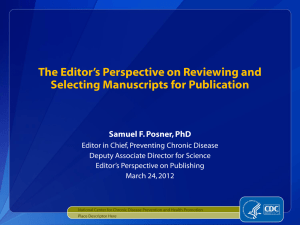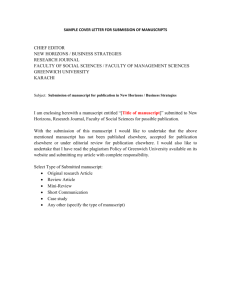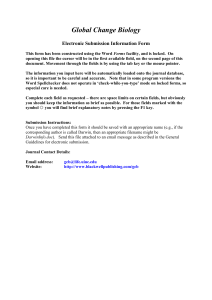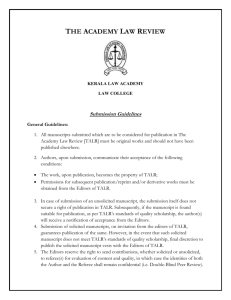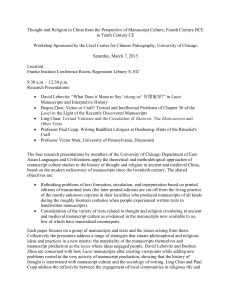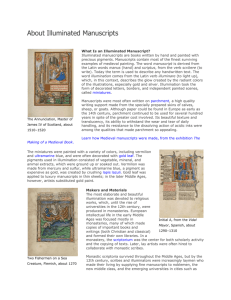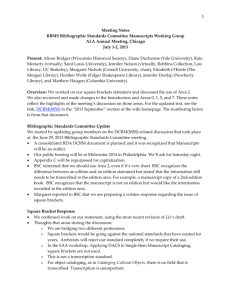Mexican Studies/Estudios Mexicanos For Authors: Submitting an
advertisement
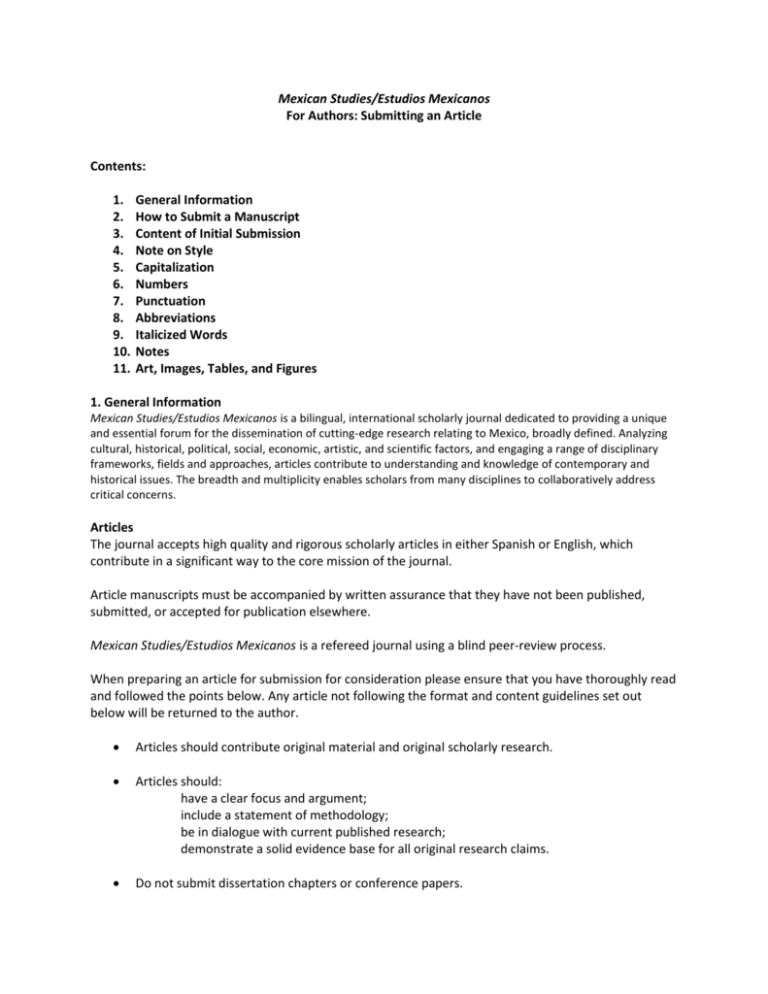
Mexican Studies/Estudios Mexicanos For Authors: Submitting an Article Contents: 1. 2. 3. 4. 5. 6. 7. 8. 9. 10. 11. General Information How to Submit a Manuscript Content of Initial Submission Note on Style Capitalization Numbers Punctuation Abbreviations Italicized Words Notes Art, Images, Tables, and Figures 1. General Information Mexican Studies/Estudios Mexicanos is a bilingual, international scholarly journal dedicated to providing a unique and essential forum for the dissemination of cutting-edge research relating to Mexico, broadly defined. Analyzing cultural, historical, political, social, economic, artistic, and scientific factors, and engaging a range of disciplinary frameworks, fields and approaches, articles contribute to understanding and knowledge of contemporary and historical issues. The breadth and multiplicity enables scholars from many disciplines to collaboratively address critical concerns. Articles The journal accepts high quality and rigorous scholarly articles in either Spanish or English, which contribute in a significant way to the core mission of the journal. Article manuscripts must be accompanied by written assurance that they have not been published, submitted, or accepted for publication elsewhere. Mexican Studies/Estudios Mexicanos is a refereed journal using a blind peer-review process. When preparing an article for submission for consideration please ensure that you have thoroughly read and followed the points below. Any article not following the format and content guidelines set out below will be returned to the author. Articles should contribute original material and original scholarly research. Articles should: have a clear focus and argument; include a statement of methodology; be in dialogue with current published research; demonstrate a solid evidence base for all original research claims. Do not submit dissertation chapters or conference papers. Articles should be a maximum of 10,000 words including notes and references/bibliography. Submissions exceeding this word count will be returned without consideration. There is no minimum word count. Manuscripts should be typed and double spaced in Times New Roman 12 point font. It is important that you review your own manuscript thoroughly before submission, checking for logic, structure, consistency of style, accuracy, grammar, spelling, and punctuation. Pay particular attention to accuracy of footnotes and references/bibliography. Manuscripts submitted with obvious errors will be returned to the author without being sent for peer review. The journal uses the Chicago Manual of Style as a guide for all matters of punctuation, capitalization, and the like. Please see below for a few specific details. For any questions consult the most recent edition of the Chicago Manual of Style. The journal accepts manuscripts in both Spanish and English. 2. How to Submit a Manuscript To submit an article to MS/EM, manuscripts must be sent as a Microsoft Word document attachment to: estudmex@lais.ucsb.edu. Please include the words “article submission” in the subject line. 3. Content of Initial Submission Please include with your submission: A separate Cover Page containing: - Article title - Name of author - Status - Affiliation - Postal address - Email address - Phone number A 100 word abstract 5–10 key words and/or phrases Disciplinary framework of article (not author’s department, but discipline to which the manuscript pertains) Word count (including all notes and references/bibliography). Please DO NOT include your name or contact information anywhere on the manuscript other than on the Cover Page (e.g. do not put your last name in front of page numbers). Please use the “Example Submission” document as a model. 4. Note on style For articles with one author the use of the personal “I” is preferable to the use of the plural “we.” 5. Capitalization Prospective authors should note the forms used in the capitalization of institutions, historical periods, and groups. Capitalize when the reference to an institution is specific, for example, the National Autonomous University of Mexico. Capitalize Chicanos, Indians, Church, and Partido Liberal when referring to the institution or group. In titles of books and articles in Spanish, capitalize only the first word and names of persons and places. In titles of series, journals, and newspapers, however, capitalize all major words, e.g., Secretaría de Programación and La Opinión. 6. Numbers Write out all numbers under 100; percentages should be numerical, e.g., 25 percent. When referring to subdivisions of a book in the text, use Volume III, chapter 18, and part one. Dates in text should follow these examples: October 7, 1941 October 1941 1940s eighteenth-century trends continued into the nineteenth century. 7. Punctuation A comma precedes the conjunction joining the last item in a series of three or more, for example, “Mexico, Argentina, and Cuba.” Mexican American and Hispanic American are not hyphenated unless they are hyphenated in the title of a book or article, in the name of an institution, or in a quotation. 8. Abbreviations Use the acronym MS/EM when citing this journal. However, when referring to other publications, associations, or institutions cite the complete name and in parenthesis the acronym which will be subsequently used in the text. Use complete first names instead of initials only. 9. Italicized Words All foreign words should be italicized with the exception of proper names. Do not use italics for words found in Webster's Third New International Dictionary of the English Language, Unabridged which contains a large number of Spanish words such as: alcalde barrio conquistador. All Spanish words should be used in their original Spanish form. 10. Notes As a general rule, please use footnotes instead of endnotes. Though there are variations in format among different disciplines, authors should consult the latest edition of The Chicago Manual of Style for all matters of style and documentation. Authors should maintain a consistent format and note the following general rules: "Op. cit." is not used. Instead, use the author's last name and a short title, whether or not more than one work by the same author is cited. Ibid. and passim are not italicized. Words to be abbreviated in notes include ed., vol., leg., exp., fol., no., diss., and n. Unless confusion would result, "p." is omitted with page numbers. 11. Art, Images, Tables, and Figures All art, images, tables, and figures should be submitted embedded in the text (not as separate files) and should include a title and/or caption and a credit line when necessary. Articles should be submitted for review with art, images, tables, and figures of low resolution, however, please note that if the article goes to press all images, figures, charts, graphs, and other artwork will need to be provided in high resolution and saved as TIF, PDF, or JPEG files. For publication, all images should be a minimum of 300dpi. Please consider the following caption examples: For tables: Table 1: Estimates of Damage Caused by the War of Independence, 1810–1816. Source notes should be included with each table. For figures: Figure 1. Advertisement in El Universal, February 24, 1951. For images: Image 1. Students gathering at the Universidad Veracruzana, March 5, 2008. Photo Credit: John Smith.

